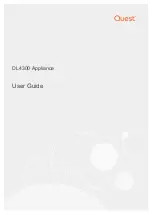
Options available for performing basic steps
When performing fault isolation and troubleshooting steps, select the option or options that best suit your site environment.
Use of any option is not mutually exclusive to the use of another option. You can use the ME Storage Manager to check the health icons/
values for the system, or to examine a problem component. If you discover a problem, either the ME Storage Manager or the CLI provides
recommended-action text online. Options for performing basic steps are listed according to frequency of use:
•
Use the ME Storage Manager
•
Use the CLI
•
Monitor event notification
•
View the enclosure LEDs
Use the ME Storage Manager
The ME Storage Manager uses health icons to show OK, Degraded, Fault, or Unknown status for the system and its components. The ME
Storage Manager enables you to monitor the health of the system and its components. If any component has a problem, the system
health is in a Degraded, Fault, or Unknown state. Use the ME Storage Manager to find each component that has a problem. Follow actions
in the Recommendation field for the component to resolve the problem.
Use the CLI
As an alternative to using the ME Storage Manager, you can run the show system CLI command to view the health of the system and its
components. If any component has a problem, the system health is in a Degraded, Fault, or Unknown state, and those components are
listed as Unhealthy Components. Follow the recommended actions in the component Health Recommendation field to resolve the
problem.
Monitor event notification
With event notification configured and enabled, you can view event logs to monitor the health of the system and its components. If a
message tells you to check whether an event has been logged, or to view information about an event, use the ME Storage Manager or the
CLI. Using the ME Storage Manager, view the event log and then click the event message to see detail about that event. Using the CLI,
run the
show events detail
command to see the detail for an event.
View the enclosure LEDs
You can view the LEDs on the hardware to identify component status. If a problem prevents access to the ME Storage Manager or the
CLI, viewing the enclosure LEDs is the only option available. However, monitoring/management is often done at a management console
using storage management interfaces, rather than relying on line-of-sight to LEDs of racked hardware components.
Performing basic steps
You can use any of the available options that are described in the previous sections to perform the basic steps comprising the fault
isolation methodology.
Gather fault information
When a fault occurs, gather as much information as possible. Doing so helps determine the correct action that is needed to remedy the
fault.
Begin by reviewing the reported fault:
•
Is the fault related to an internal data path or an external data path?
•
Is the fault related to a hardware component such as a disk drive module, controller module, or power supply unit?
By isolating the fault to one of the components within the storage system, you are able determine the necessary corrective action more
quickly.
Determine where the fault is occurring
When a fault occurs, the Module Fault LED illuminates. Check the LEDs on the back of the enclosure to narrow the fault to a CRU,
connection, or both. The LEDs also help you identify the location of a CRU reporting a fault.
Troubleshooting and problem solving
71
















































